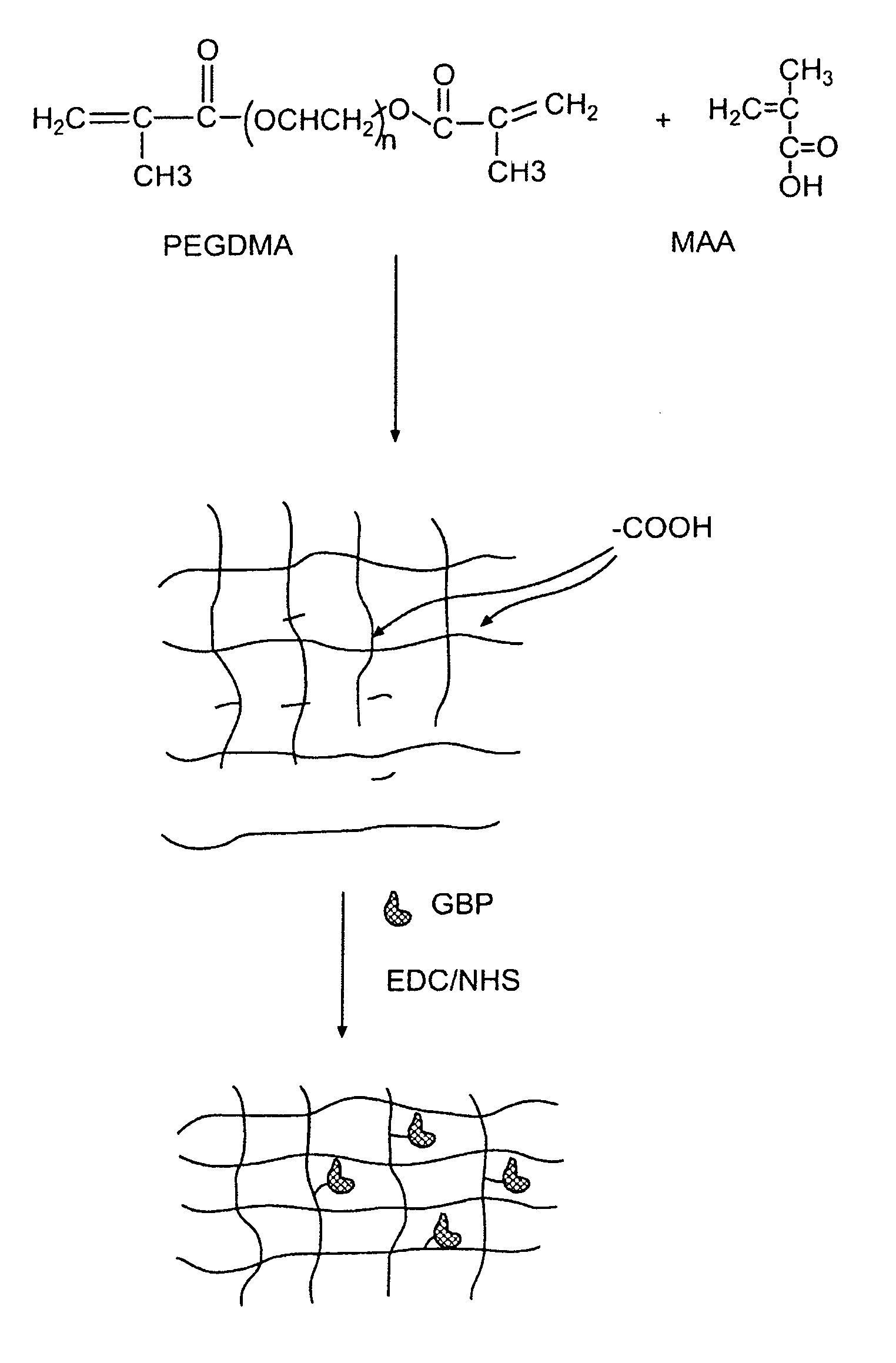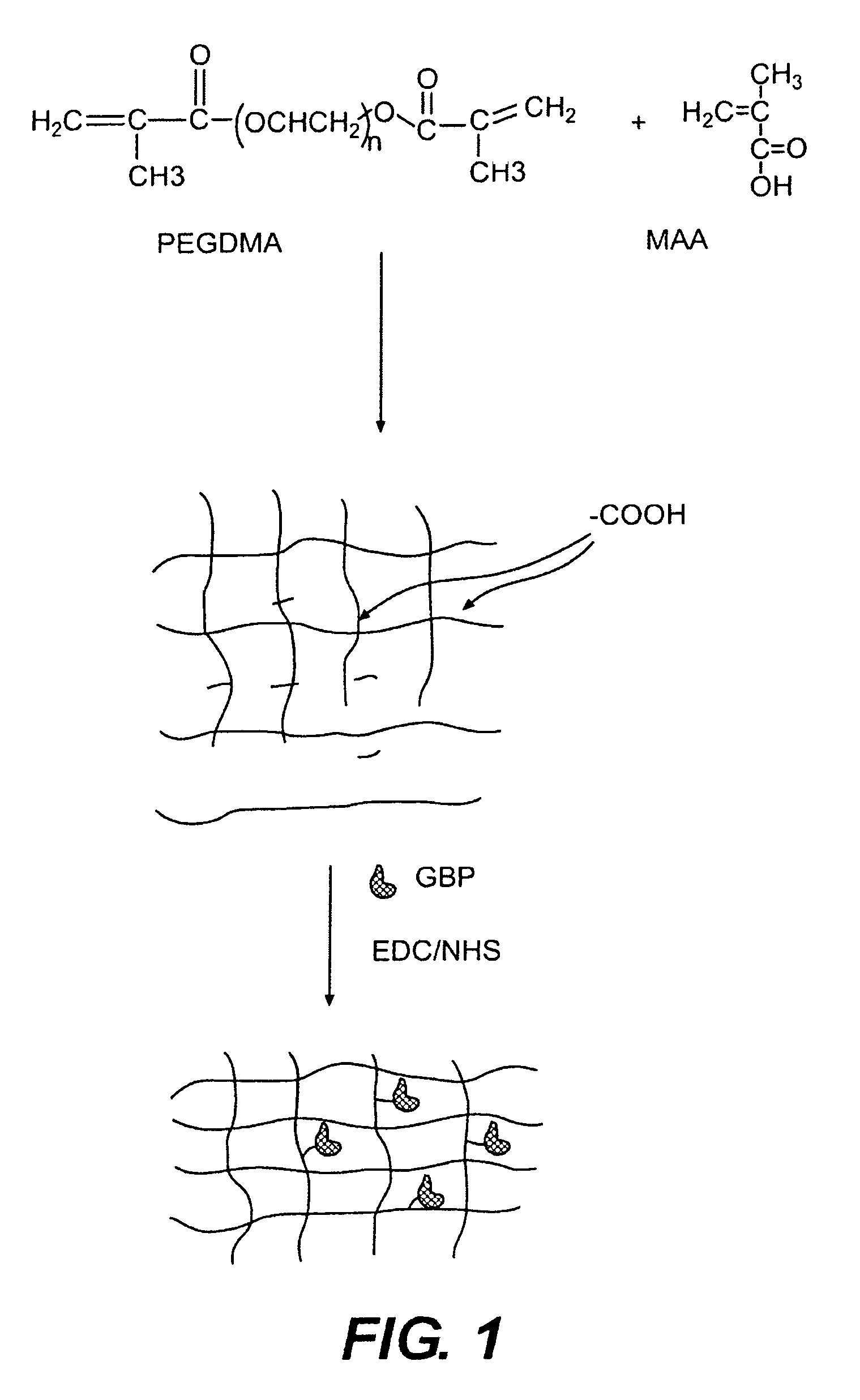Hydrogel compositions
a technology of hydrogel and composition, which is applied in the field of compositions comprising hydrogel, can solve the problems of affecting the movement of materials, affecting the stability of materials, and affecting the quality of materials,
- Summary
- Abstract
- Description
- Claims
- Application Information
AI Technical Summary
Benefits of technology
Problems solved by technology
Method used
Image
Examples
example 1
In Vivo Performance of PEGDMA-MAA Sensors
[0052]In this experiment, the modified GGBP termed “W183C,” as described in United States Published Application 2004.0118681, was used. Typical PEGDMA-MAA fiber sensors containing Acrylodan-W183C-GBP were fabricated with the process depicted in FIG. 3. PEGDMA, MAA and photo-initiator HMPP (2-Hydroxy-2 methyl propiophenone) were mixed in appropriate molar ratios and deposited on optical fiber tips. PBS was used as the reaction solvent forming the hydrogel with the HMPP added last after all reagents have been dissolved and thoroughly mixed. The fibers were first treated with a 5N sulfuric acid wash followed by a 45 minute treatment of Acrylopropyltrimethosilane (AcPTMS). The hydrogel was completely cured under a Hg lamp with (>360 nm wavelength) for ˜15 seconds (the jumper set-up to deliver ˜50-65 mW / cm2 to the end of the jumper) followed by immediate storage in 0.01M MES pH=0.65.
[0053]Tables 1 and 2 show the constituents of the hydrogel formul...
example 2
Improved PEGDMA-MAA Sensors In Vivo Performance
[0058]The photo-polymerization and protein immobilization procedure described in example 1 was further optimized. The UV power was increased 4 times by removing UV light filter and protein immobilization was conducted in presence of 30 mM glucose for better protection of protein binding activity during coupling process. The post-polymerization rinse and protein infusion buffer pH was also optimized for protein favorable pH. The PEGDMA-M sensors fabricated with the optimized process have improved sensor signal (F0), dynamic range (QR) and here are termed as PEG 4 (PEGDMA:MAA ratio of 44:56 mol %) sensors.
[0059]In the animal experiments, 14 of total 15 PEG 4 sensors tracked glucose changes after implanted for 72 hours in swine. The average 72 hours sensor signal intensity loss in vivo was 53% versus 23% for in vitro controls.
[0060]Similar experiments were carried out using either the SM4 (Pre-Grant Publication No. 2008 / 0044856) mutant GGB...
example 3
Production of a Biosensor with a Hydrogel Comprising Methacrylated Heparin
[0062]Incorporation of heparin into a hydrogel was accomplished by chemically modifying heparin sodium salt. The ring-opening reaction of the epoxide glycidyl methacrylate (GMA) was carried out with K2CO3 in H2O (pH 10.5) at 40° C. over 16 hours with GMA in 25-fold excess. The crude reaction product was precipitated into 25× ethanol to remove any non-reacted GMA, then filtered and re-suspended in diH2O and subsequently lyophilized. The synthesized heparin-methacrylate (HP-MA) monomer was then used as a 2nd layer formulation on top of a first hydrogel coating on a needle, with the free vinylic protons incorporated into the polymer backbone.
[0063]A pre-coating is first applied using a 1-5 second “dip”, preferably a 3-second dip to a highly wettable surface. A 5-10 second ultraviolet light exposure, preferably a 6 second exposure, polymerized the coating, causing the coating rapidly adhere to both the device surf...
PUM
| Property | Measurement | Unit |
|---|---|---|
| depth | aaaaa | aaaaa |
| depth | aaaaa | aaaaa |
| depth | aaaaa | aaaaa |
Abstract
Description
Claims
Application Information
 Login to View More
Login to View More - R&D
- Intellectual Property
- Life Sciences
- Materials
- Tech Scout
- Unparalleled Data Quality
- Higher Quality Content
- 60% Fewer Hallucinations
Browse by: Latest US Patents, China's latest patents, Technical Efficacy Thesaurus, Application Domain, Technology Topic, Popular Technical Reports.
© 2025 PatSnap. All rights reserved.Legal|Privacy policy|Modern Slavery Act Transparency Statement|Sitemap|About US| Contact US: help@patsnap.com



